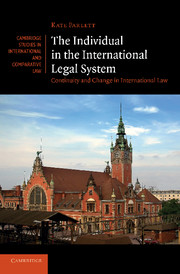Book contents
- Frontmatter
- Contents
- Foreword
- Acknowledgements
- Select list of abbreviations
- Table of cases
- Table of treaties
- Part I The Framework
- 1 Structures of the international legal system
- Part II The Individual in International Law
- Part III Reassessing the Framework
- Bibliography
- Index
- CAMBRIDGE STUDIES IN INTERNATIONAL AND COMPARATIVE LAW
- References
1 - Structures of the international legal system
Published online by Cambridge University Press: 19 May 2011
- Frontmatter
- Contents
- Foreword
- Acknowledgements
- Select list of abbreviations
- Table of cases
- Table of treaties
- Part I The Framework
- 1 Structures of the international legal system
- Part II The Individual in International Law
- Part III Reassessing the Framework
- Bibliography
- Index
- CAMBRIDGE STUDIES IN INTERNATIONAL AND COMPARATIVE LAW
- References
Summary
Introduction
At least by the nineteenth century, international law was generally conceived as a body of rules and forms of conduct applicable to states in their relations with each other. During the twentieth century, a more multifaceted and cosmopolitan view of legal relations in international law emerged. It is widely thought that individuals now have a certain status in international law as the beneficiaries of rights and the bearers of obligations, although they are not subjects of international law of the same kind or to the same extent as states. There has thus been a significant shift in attitudes towards the individual and individual rights over the period since Vattel. But while in some fields of international law it is uncontroversial to treat individuals as holding rights (for example, in international human rights law) and bearing obligations (in international criminal law), in other fields there is uncertainty about the status of the individual. Moreover, although it is now accepted that individuals are ‘subjects’ in some sense, there is little consensus about what that means for the extent to which individuals engage in the international legal system and are engaged by it.
In the relatively open and flexible international system of the twenty-first century, the formal status of entities may seem to have little significance. Whether an individual is a direct right-bearer or an indirect beneficiary of an inter-state obligation may seem to be a distinction without a difference for the operation of the primary rules of international law: either way, the individual benefits from some substantive right, held either directly or through its state of nationality.
- Type
- Chapter
- Information
- The Individual in the International Legal SystemContinuity and Change in International Law, pp. 3 - 44Publisher: Cambridge University PressPrint publication year: 2011
References
- 1
- Cited by

